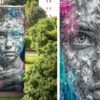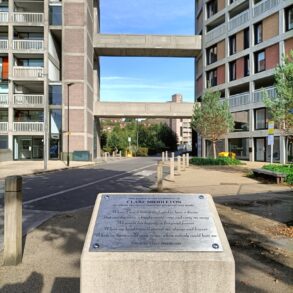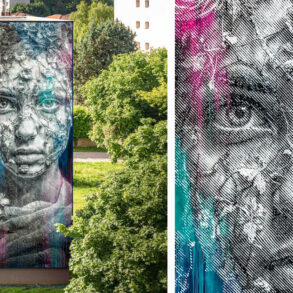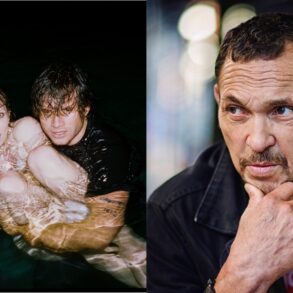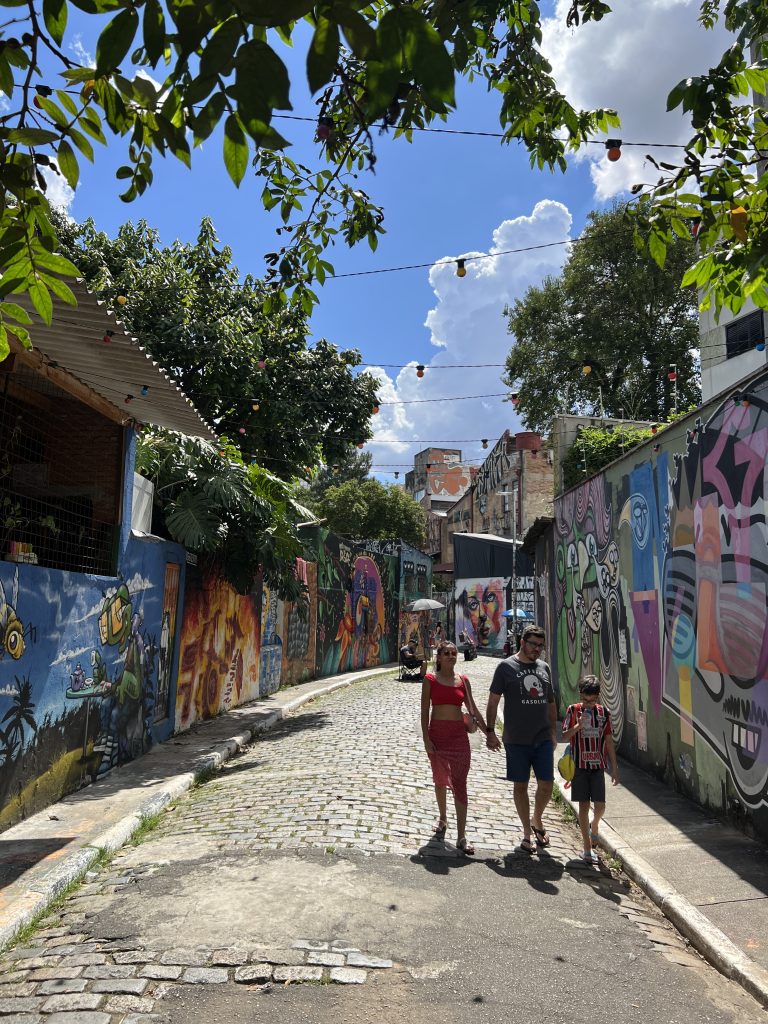 Beco do Batman/Photo: Simon Watson
Beco do Batman/Photo: Simon WatsonFor any cultural explorer seeking the thrill of new and challenging art, São Paulo is a remarkable destination. As one of the largest cities in the world, it presents a dynamic juxtaposition of gritty street culture and towering edifices erected by industrial titans. As Brazil’s economic powerhouse, it’s experienced significant growth, largely influenced by its vibrant immigrant population. The city thrives on its multicultural roots, which are vividly reflected in its diverse artistic expressions.
The city’s walls serve as a canvas for expression, revealing runes left by artists who speak of hope, love and fury on behalf of the dispossessed. The visual presence of mural painting—both legal and illegal—as well as pichação, the hieroglyphic street graffiti seen on buildings and walls, cannot be overstated. As noted by The Guardian, “In a city locked in by traffic and grey high-rises, these long swaths of colorful, ever-changing graffiti images—beautiful, ugly, political and sometimes offensive—serve as jagged cuts in the city’s visual monotony.” This vibrant street-art scene not only enhances the urban landscape but also offers a voice to the marginalized, allowing them to communicate their stories and struggles through visual means.
The urban art culture in São Paulo has evolved significantly over the decades, beginning with the first generation of rebels from the late 1970s to the early 1990s, whose street-painting actions were strictly illegal. However, a major transformation occurred in 2006 when São Paulo’s mayor passed the Clean City Law, which banned all public advertising. This remarkable act transformed the urban landscape. As Vinicius Valvao, a reporter at Folha de São Paulo, explains, “São Paulo is a very vertical city. That makes it very frenetic. You could not even realize the architecture… all the houses were just covered with billboards and logos and propaganda.” With the eradication of mainstream advertising, the cityscape became a blank canvas, offering graffiti artists unprecedented opportunities to claim their space.
A significant turning point came in 2019 with the establishment of the Street Art Museum. Launched by the Municipality of São Paulo in collaboration with the Municipal Department of Culture and Subprefectures, this initiative aimed to encourage the development of urban art throughout the metropolis. Historically, street art was often treated as vandalism, and artists faced numerous challenges in securing authorization for their works. The Street Art Museum project provides a framework for organizing the distribution of new murals across the city, encompassing more than 300 murals.
For anyone making a brief visit to São Paulo, the following urban-canvas highlights have been selected by a dozen of the city’s knowledgeable insiders from four neighborhoods: Vila Madalena, Pinheiros, Avenida Paulista and Centro.
Vila Madalena
Beco do Batman (Batman’s Alley) in Vila Madalena is perhaps the most well-known neighborhood for street art and graffiti in all of São Paulo. Stepping into Beco do Batman feels like entering another world. Every inch of the walls is adorned with intricate graffiti, murals and street art, each telling its unique story. From political statements to abstract dreams, the range of themes and techniques is impressive, making Beco do Batman the highest concentration of street art in the city. The nickname for the area is attributed to a graffito of the DC Comics character Batman, which was painted on one of the walls in the 1980s. That singular act led to an influx of artists who painted murals, transforming this lane into a colorful and vast collage of art. Over time, the alley has evolved into an outdoor gallery, drawing not only locals but also international visitors.
When visiting Beco do Batman, be sure to walk around the district, particularly to a neighboring park, Praça José Afonso de Almeida. Look for a staircase on one side of the park between Rua Simpatia and Rua Aspicuelta, where you’ll find free-hand painted heads by the late John Howard, one of the first-generation street artists. Suggested by journalist Lia Hama, this site features five John Howard heads. In a brilliantly informative essay in Revista Piauí at the time of John Howard’s death in July 2024, Hama wrote, “He was responsible for the beginning of graffiti in São Paulo. A genius who inspired us greatly with his talent, his attitude, and his incredible stories. Rest in peace.” With this message, artists Otávio and Gustavo Pandolfo, known as Osgemeos, bid farewell to John Howard on social media, acknowledging him as a pioneer of graffiti in São Paulo. John is revered by generations of graffiti artists who followed him on the streets. “He was a trailblazer, one of the most important figures of that first generation from the late 1970s and early 1980s,” says Otávio, fifty, a member of the second generation and world-famous alongside his twin brother. “During the dictatorship, he started painting during the day on large avenues when almost no one else was doing that.”
Selected Murals in Vila Madalena
Beco do Batman
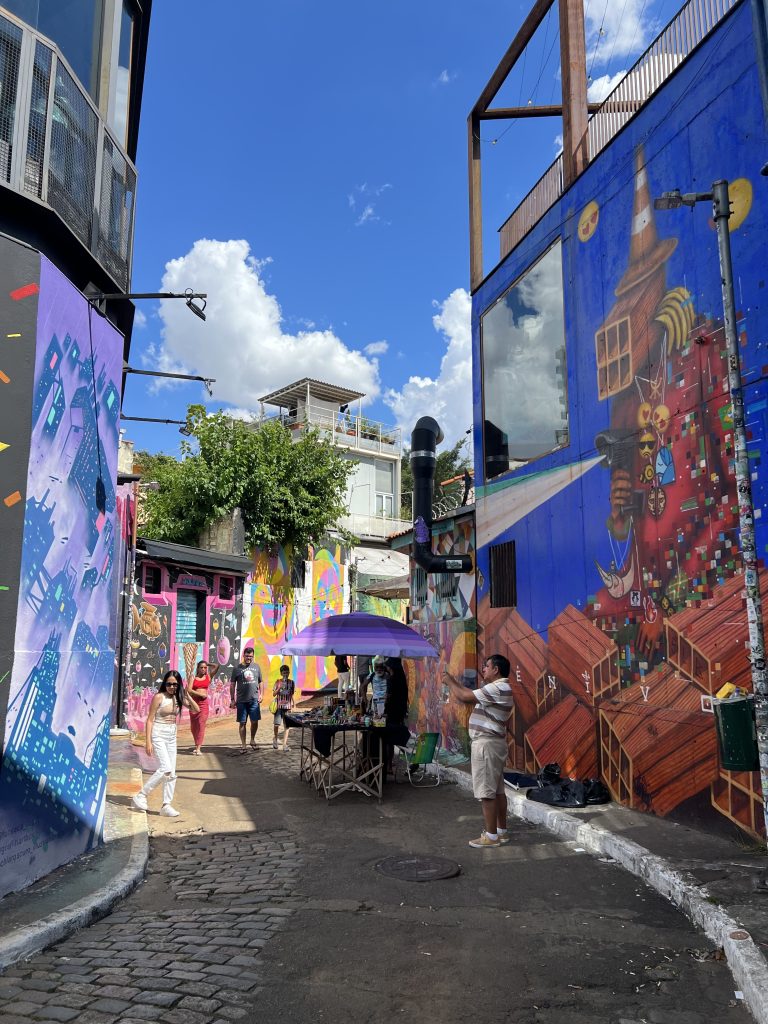



John Howard, “Cabeças-Feitas,” circa 2000s
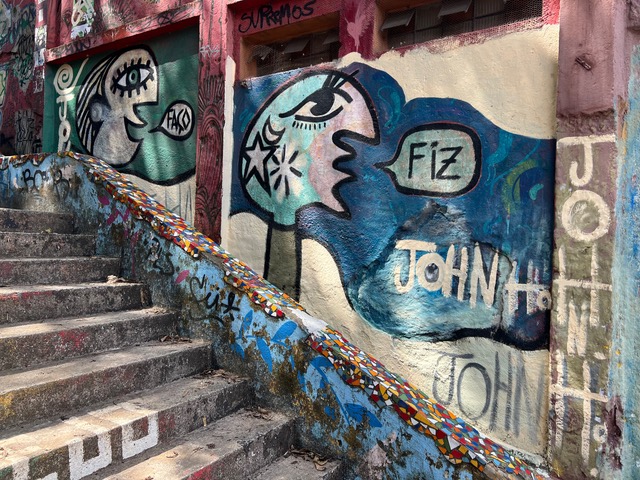



Location: Escadaria do Beco, Praça José Afonso de Almeida, Vila Mariana [On the staircase wall between Rua Simpatia and Rua Aspicuelta]
Mural selected by Lia Hama, journalist, Revista Piauí
Pinheiros
In the Pinheiros district, no more than a half-mile from Instituto Tomie Ohtake, is a public square known as Largo da Batata (Potato Square or Potato Plaza) because since the 1920s there had been a concentration of potato vendors at its municipal market for agricultural products. The vegetable market has now given way to realtors who have been sprouting tall buildings everywhere, including office centers located on Avenida Faria Lima and residential buildings just off the busy avenue. This area of Pinheiros has become an excellent neighborhood for discovering dozens of murals, thanks to the annual NaLata Festival curated by Luan Cardoso, who has encouraged an international array of artists to paint murals.
Almost hidden from sight among the tall buildings and nestled in a pink chain-link-fenced parking lot is a massive wall relief created by Vhils, the noted Portuguese artist who carves using everything from power tools to explosives to create large-format portraits. From a distance, the effect resembles an etching plate. On closer inspection, the mural depicts numerous portraits collaged together, paying tribute to Brazilian diversity.
Selected Murals in Pinheiros
Vhils, “Manta de retalhos–Descascando a superfície”
(Patchwork blanket–Peeling the surface), 2023




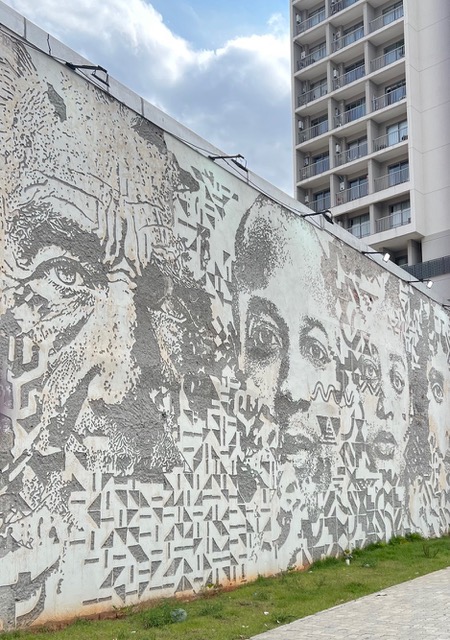



Location: Avenida Faria Lima, 822 (Look inside the parking lot: Estacionamento LAPI Faria Lima)
Mural selected by Luan Cardoso, NaLata Festival curator and founding director and Luis Maluf, Galeria Luis Maluf gallerist
Felipe Pantone, “300,000 Km/s,” 2022
One short block’s walk from Vhils’ mural, further along Avenida Faria Lima, look up to discover Felipe Pantone’s “300,000 Km/s.” Pantone evokes a spirit in his work that feels like the city has collided with a digitized future, where human beings and machines glitch alongside one another in a prism of neon gradients, geometric shapes, optical patterns and jagged grids. Says the artist about this brilliantly colored mural, ”A friend of mine told me that it feels like a splash of light for the city; that’s exactly how I see it.”
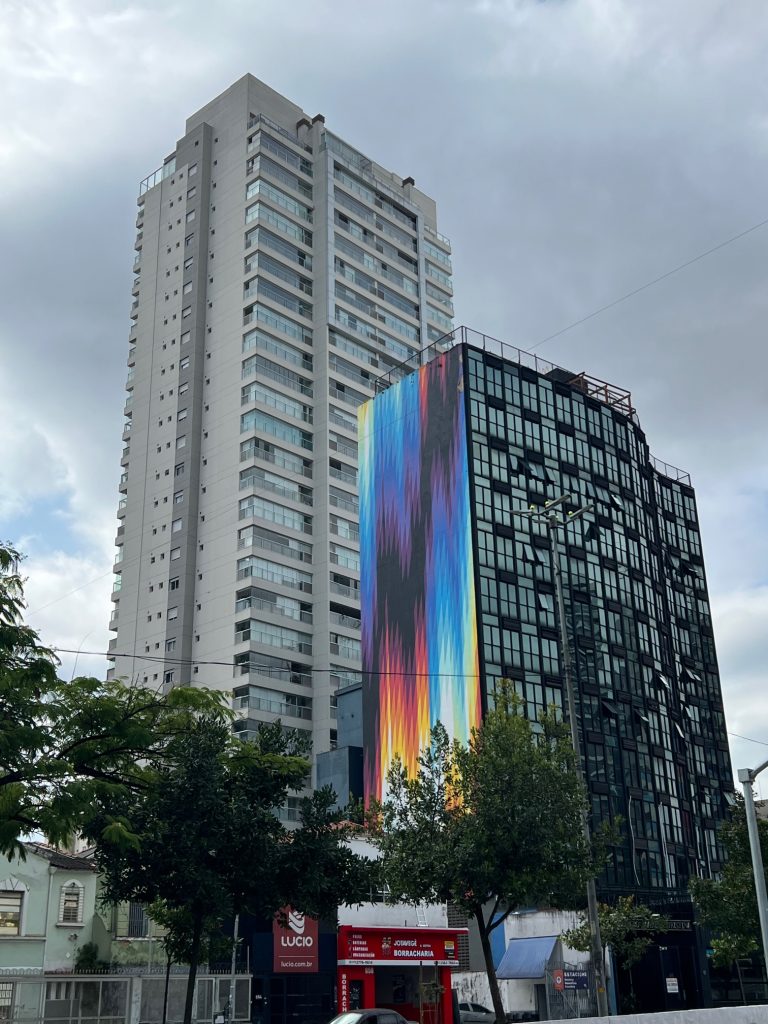



Location: Avenida Faria Lima, 664
Mural selected by Tito Bertolucci, noted street-art collector and founding director Alma da Rua
Avenida Paulista
In addition to being the city’s best-known thoroughfare, Avenida Paulista is home to many museums and cultural venues, bordering the extensive shopping and culinary area of Jardins. Avenida Paulista boasts South America’s most comprehensive fine-art museum, the São Paulo Museum of Art (MASP), designed by Italian-Brazilian architect Lina Bo Bardi. From there, a walk down Paulista leads to Instituto Moreira Salles (IMS Paulista), which is well worth a visit. From the glass-encased upper levels, you can spy a superb mural by Criola at the corner of Avenida Paulista and Rua da Consolação.
Selected Murals on Avenida Paulista
Criola, “A Ancestral do Futuro” (The Ancestor of the Future), 2021
Criola’s bold blue mural “The Ancestor of the Future” is a portrait of Afro-Brazilian author and poet Carolina Maria de Jesus, a single mother who lived with her three kids in a shack in Favela do Canindé, barely making enough money to eat most days. Through her writing, and in particular her published diary, she was a revolutionary who challenged the global image of Brazil’s natural beauty with the ugliness of favela life. Carolina Maria de Jesus’ diaries were edited into a book called “Room of Garbage” (1960), which quickly became one of the most successful books in Brazilian publishing history. In São Paulo, 10,000 copies of the book sold out in the first three days and it has since been translated into thirteen different languages, becoming an international bestseller. The book begins: “July 15, 1955. The birthday of my daughter Vera Eunice. I wanted to buy a pair of shoes for her, but the price of food keeps us from realizing our desires. Actually we are slaves to the cost of living.” Carolina Maria de Jesus’ stories humanize poverty and hunger, bringing attention to the human lives behind facts and figures. She describes the pain of hearing her children ask for more food because they are still hungry.
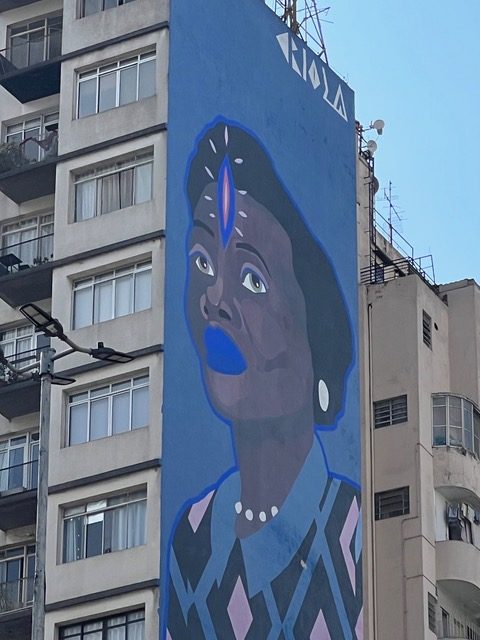



Location: Rua da Consolação, 2570 – Pacaembu (at the T-junction of Avenida Paulista)
Mural selected by Simon Watson
Eduardo Kobra, Ayrton Senna: “A lenda do Brasil” (The Brazilian Legend), 2015
Carlos Eduardo Fernandes Léo, known as Eduardo Kobra, is a street muralist who has painted over 3,000 murals on five different continents. In 2015, on the eve of the Brazilian Formula One Grand Prix, Kobra received permission from the family of the late great racing car driver Ayrton Senna to officially paint the national hero. At the Ayrton Senna Institute, he was able to research the institution’s photographic archives, which serves as the basis for his large panel, an image in which the focus is solely on Senna’s eyes. “Nothing more than that was needed. The look sums up and demonstrates everything he is.”
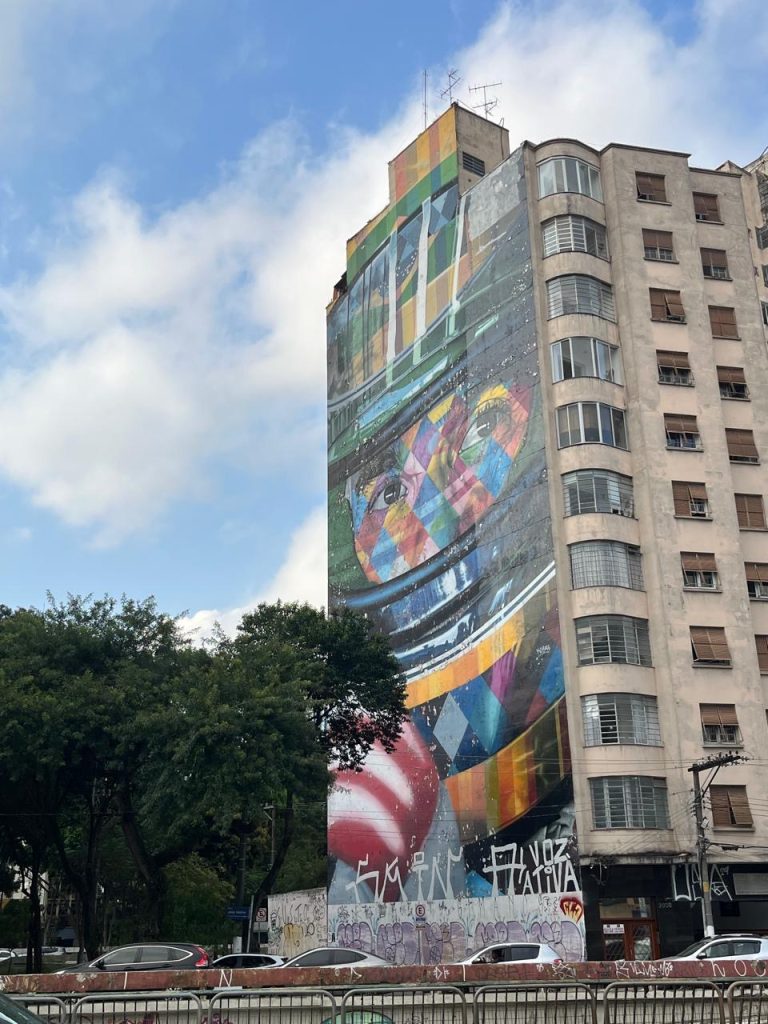



Location: Rua da Consolação, 2,608 (on the corner of Avenida Paulista)
Mural selected by Jade Matarazzo, curator
Speto, “Don Quixote”
Paulo Cesar Silva, a visual artist and illustrator known as Speto, is among the second generation of street artists in São Paulo. Inspired by popular literature and woodcuts, as well as traditional tattoo designs and manga, his works can be found in more than fifteen countries. For the Rosewood São Paulo, Speto’s mural adorns the main entrance to the hotel’s lobby. The project, in black, white and red, depicts a sea of whales, one of the most imposing living beings in nature.
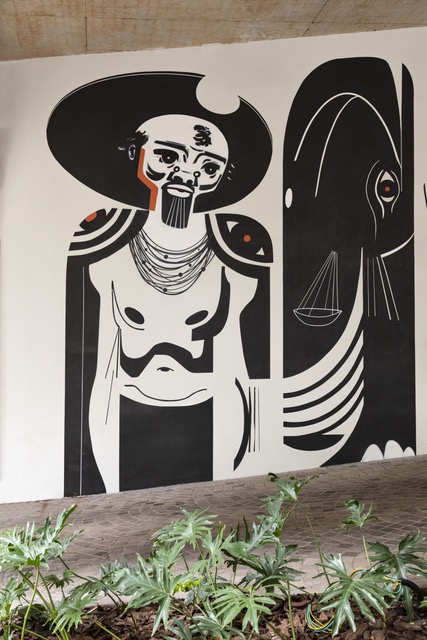



Entrance lobby for Rosewood-Cidade Matarazzo
Location: Rua Itapeva, 485 – Bela Vista
Mural selected by Marc Pottier, curator
Centro
For a captivating blend of art and urban exploration, take a Sunday stroll along São Paulo’s Minhocão, an elevated highway bisecting the city’s center, which transforms into a pedestrian park on the weekend. It offers a unique vantage point to appreciate the vibrant street art that adorns the city’s buildings. Surrounded by fellow sun worshippers, you can feel São Paulo’s artistic spirit, a testament to the city’s rich cultural tapestry.
Selected Murals in Centro
Tec Fase, “Homem Urbano” (Urban Man)
Argentine artist Tec Fase’s “Homem Urbano” (Urban Man) is a twenty-story mural (sixty-four meters) representing a playful depiction of a hollowed-out face, perhaps symbolizing the effect of urban life. It resonates deeply within the bustling metropolis, inviting viewers to ponder their place in this sprawling concrete jungle.




Location: Rua Amaral Gurgel, 175 – Vila Buarque
Mural selected by Baixo Ribeiro, educator and Choque Cultural gallerist
Apolo Torres, “Nina: Educação Não É Crime” (Nina: Education Isn’t A Crime), 2016
In Apolo Torres’ mural, a girl tries to reach books floating in the sky, while venomous animals try to stop her from achieving her dream. Torres created this image in 2016 to address limited access to higher education in his home country. In an interview, he said, “I wanted to do something comprehensive enough to address two problems: the Iranian issue and the Brazilian issue, where access to education is also so complex. The title of the work, ‘Nina’, is also my daughter’s name. I projected how much I would like her to be able to dream of whatever she wants, without restrictions.”




Location: Rua Amaral Gurgel, 593, Vila Buarque – Praça Roosevelt
Mural selected by Julia Bolliger, social media arts editor, Bienal de São Paulo
Marcela Scheid, “Incômodo” (Uncomfortable), 2023
Marcela Scheid’s work “Uncomfortable” (2023), on Mário de Andrade Street, does justice to the poet who lends his name to this street. In reds, pinks, blacks and whites, the visual artist, designer and writer creates a striking visual as a reminder that every new beginning implies an end, and therefore, transformations are accompanied or even driven by discomfort.
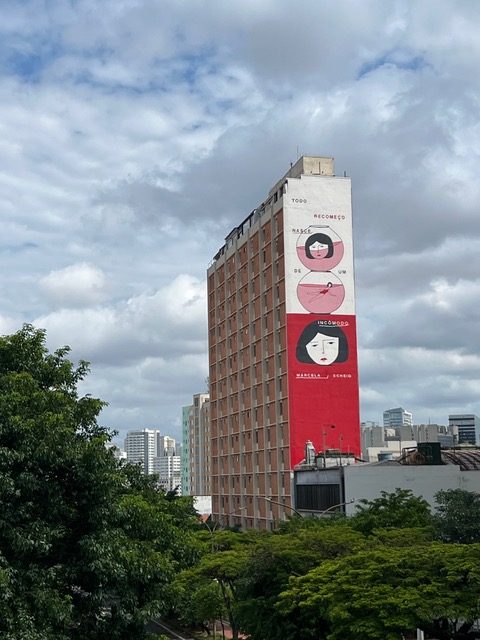



Location: Rua Mário de Andrade, 100 – Barra Funda
Mural selected by Gabriela Longman, journalist, Folha de São Paulo
Enivo, “Xamã Urbano” (Urban Shaman), 2020
New York-based cultural critic and curator Carlo McCormick has been observing and savvily writing about the city’s street and nightlife scenes since the 1980s. In discussing Enivo’s “Rainbow Warrior” paintings and murals such as “Xamã Urbano” (Urban Shaman), McCormick says, “Enivo believes in magic. His art’s very much about that. And what’s kind of nice is that instead of all this spiritual wonky shit, his notion of transcendence, or whatever he’s looking for, that kind of beautiful thing, is very much invested in the quotidian… There’s a lot of optimism and empowerment in the rainbow. It has its connotations across a lot of cultures, and it’s all aspirational to me. And yeah, I just think he has this really deep love of… I hate to use phrases like ‘the common people’ or something like that, but he vests a lot of love into people that aren’t really paid attention to that much. And it’s almost like he’s turning these characters into ritualized, god-like beings—and they’re fighting for love or for their presence in the world.”
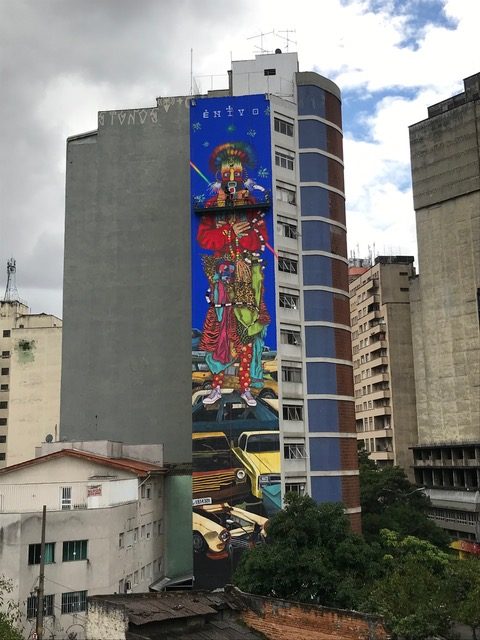



Location: Centro
Mural selected by Tatiane de Assis, journalist, Revista Piauí
Alexandre Orion,”Ossário”
São Paulo-based Alexandre Orion has developed a unique artistic technique using automotive soot as a central medium, transforming environmental degradation into thought-provoking works of art. For the project “Ossário,” the artist uses fabric scraps to clean the soot from the walls of São Paulo’s automotive tunnels. At this nocturnal intervention, he selectively removes layers of pollution left by passing cars so as to create skulls, thousands of skulls. The work of Alexandre Orion was suggested to us by Silas Martí, noted art critic for Folha de São Paulo.
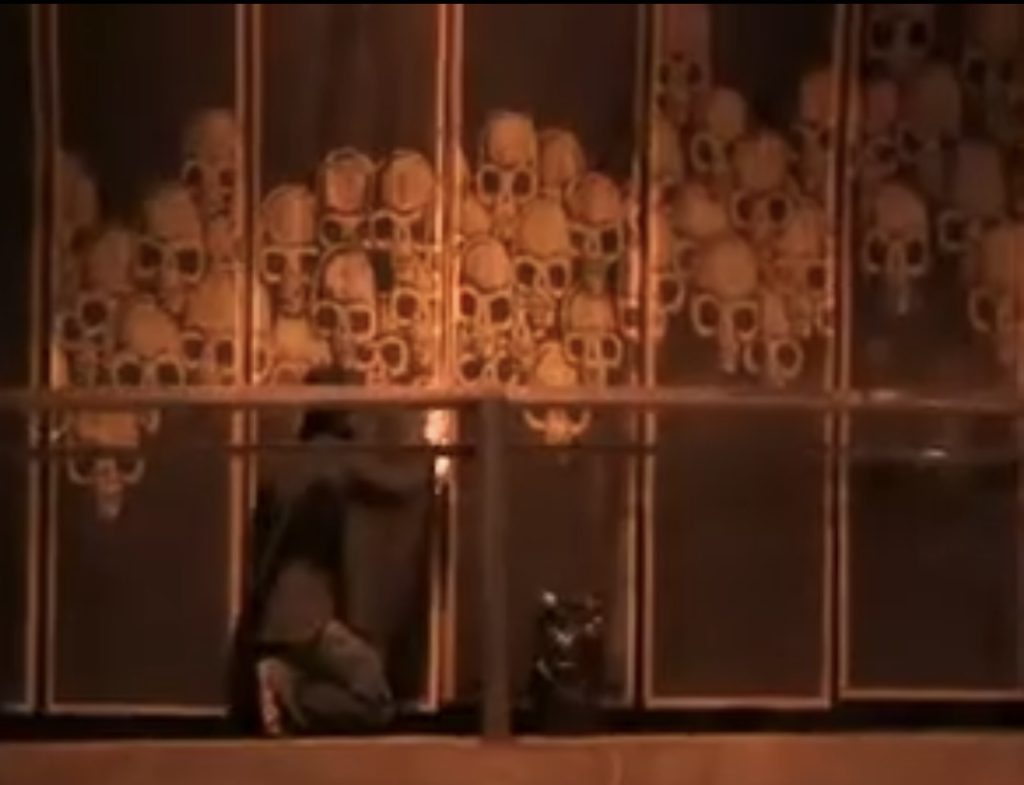



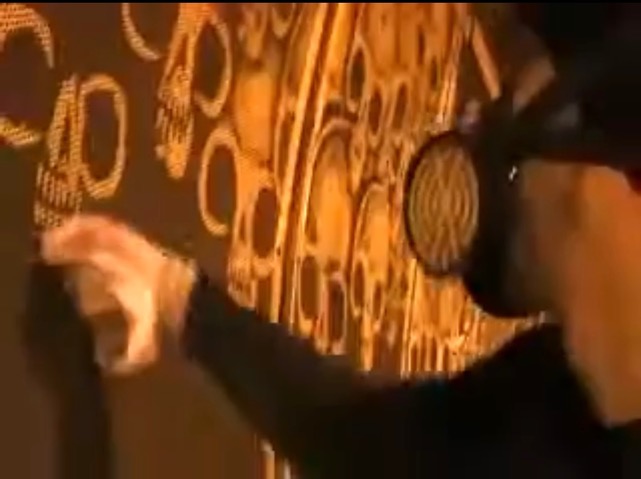



In Memoriam
Daniel Melim, “Mural da Luz” (2011)
“Mural da Luz” (2011) by Daniel Melim is lamented for its passing by many including Silas Martí, art critic, Folha de São Paulo. Recently erased to a grey blob, the formerly bright Pop Art-styled mural had been located on the side of a building facing the Pinacoteca de São Paulo and was one of the first works in the city to receive sponsorship through the Clean City Law. Daniel Melim’s now-phantom mural remains a poignant reminder of the ever-changing landscape of São Paulo’s street-art scene. However, a Melim painting directly relating to the imagery of his “Mural da Luz” currently hangs at Pinacoteca de São Paulo in a display from the museum’s permanent collection.
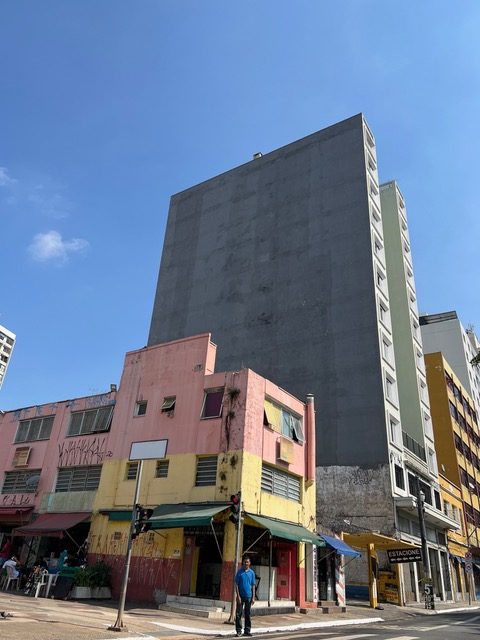



São Paulo stands as a vibrant canvas of cultural exploration, where art transcends mere decoration and becomes a powerful medium for social commentary and identity. The city’s streets are alive with stories, struggles and triumphs, inviting all who wander through its neighborhoods to engage with the living art that defines its urban landscape. For anyone seeking a deeper understanding of contemporary art and its role in shaping societal narratives, São Paulo is an essential destination.
This post was originally published on this site be sure to check out more of their content.


